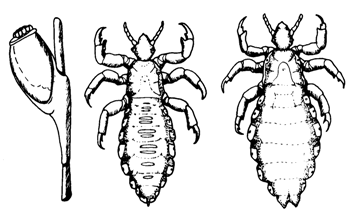|
CORRESPONDENCE
COURSE
U.S. ARMY MEDICAL DEPARTMENT CENTER AND SCHOOL
SUBCOURSE MD0152 EDITION 100
DISEASES OF MILITARY IMPORTANCE
Throughout the history of the world, disease has been man’s worst
enemy. Probably the most dreadful episode in recorded history was the
infamous “Black Death” epidemic of the 14th century, which was
responsible for the death of one-fourth of the population of Europe.
Other epidemics, though not so dramatic as the plague epidemic, have
wreaked havoc upon civilizations and primitive populations as well.
When diseases are present in the general population, the hazard is
even greater to armies. Because of the large numbers of soldiers who
live in close association with one another--sometimes in a hostile
environment and with less than desirable facilities--diseases, once
started, can run rampant if they are not immediately checked.
Until World War I, disease took a far greater toll of manpower than
did enemy fire. Napoleon Bonaparte, though considered a military
genius, lost over 400,000 of his. 500,000-man army which invaded
Russia in 1812 to disease and cold injury, while only 60,000 were
killed as a result of direct battle injury. In a previous expedition
in Haiti, he had lost 20,000 of a 22,000-man force to the ravages of
yellow fever.
The U.S. experience has not been without similar tragedies. During the
Civil War, more than twice as many men in both the Union and
Confederate armies died from disease as from battle wounds. During the
Spanish-American War, more than seven men died from disease (primarily
yellow fever) to each man who fell in combat.
Improved medical techniques, antibiotics, and research have done much
to bring disease, as a military factor, under control; however,
hospital admissions due to disease and noncombat injury continue to
far outweigh those due to direct battle causes. It is, thus, of the
utmost importance that you know and understand the causes and means of
prevention of those diseases that are of military importance.
----------------------
Length: 265 Pages
Estimated Hours to Complete: 20
Format: PDF file
Size: 1.9 MB
----------------------------
Anyone may take this course. However, to receive credit hours, you
must be officially enrolled and complete an examination furnished by
the Nonresident Instruction Branch at Fort Sam Houston, Texas.
Enrollment is normally limited to Department of Defense personnel.
Others may apply for enrollment, but acceptance is not guaranteed.

Diseases of Military Importance
Distance Learning
Course
265 Pages
Est. 20 Hours
1.9 MB pdf file
Download Now |
|

TABLE OF CONTENTS
INTRODUCTION
1 GENERAL CONCEPTS
Section I. Introduction
Section II. Communicable Diseases
Exercises
2 FOOD- AND WATERBORNE DISEASES
Section I. The Diseases
Section II. Control Measures of Food and Water-Borne
Diseases
Exercises
3 RESPIRATORY DISEASES
Section I. Epidemiology of Respiratory Diseases
Section II. Troop Housing and Respiratory Disease
Control
Exercises
4 INJURIES DUE TO ENVIRONMENTAL EXTREMES
Section I. Environmental Cold Injuries
Section II. Environmental Heat Injuries.
Exercises
5 ARTHROPOD-BORNE DISEASES
Section I. Introduction to Military Medical
Entomology
Section II. Mosquito-Borne Diseases
Section III. Mosquito-Borne Diseases - Malaria
Section IV. Environmental Control of the Mosquito
Section V. Mosquito-Borne Diseases - Arbovirus
Diseases
Section VI. Mosquito-Borne Diseases - Filariasis
Section VII. Fly-Borne Diseases
Section VIII. Flea-Borne Diseases
Section IX. Tick-Borne Diseases
Section X. Mite-Borne Diseases
Section XI. Louse-Borne Diseases
Exercises
6 PEST MANAGEMENT IN A FIELD ENVIRONMENT
Section I. Responsibilities
Section II. Organization for Arthropod-Borne Disease
Control
Section III. Pest Control Operations
Section IV. Pesticides and the Environment
Section V. Insecticides
Section VI. Rodenticides
Section VII. Fumigants
Section VIII. Pesticide Safety
Exercises
7 MISCELLANEOUS DISEASES AND IMMUNIZATIONS
Section I. Viral Hepatitis
Section II. Tetanus
Section III. Zoonoses: Rabies
Section IV. Zoonoses: Leptospirosis
Section V. Immunization
Exercises
APPENDIX Food Inspection Service Guide
---------------------------------------
LESSON 1
GENERAL CONCEPTS
Section I. INTRODUCTION
1-1. PURPOSE
The purpose of this subcourse is to discuss the
epidemiology, and the control of diseases of actual or potential
military importance. The viewpoint is that of the commander and his
medical advisors in a war or preparation for war setting.
·
The commander has an interest in the health of
individuals and groups making initial entry into the Army.
·
The commander is interested in the threat to troops
from disease endemic or epidemic in areas of the world that is actual
or potential battlegrounds or training grounds.
·
The commander is interested in non-effectiveness
and lost time because of diseases his command is likely to experience
under various circumstances.
·
The commander’s interest is clear-cut, because his
responsibility for the health of those under his command is clearly
defined.
·
Peacetime incidences and experience rates are
important considerations, too, in that communicable diseases, which
cannot be eliminated or effectively controlled in peacetime generally,
are the ones most likely to become epidemic in war.
1-2. DISEASE AND INJURY IN WARTIME
History shows that disease and injury, as military
problems are factors for which the military leader must plan. In Table
1-1, the periods of war listed were ones in which combat was
the heaviest. In spite of these concentrated fighting periods,
hospital admissions for disease and non-battle injury far exceeded
admissions because of hostile action of the enemy. Furthermore,
experience reveals that hospital admissions for disease usually exceed
hospital admissions for non-battle injury and battle injury combined.
For example, of the 81.8 percent hospital admissions for disease and
noncombat injury in Vietnam in 1969, only 13.7 percent were for
nonbattle injury and 68.1percent were for disease.
1-3. PREVALENCE OF DISEASE IN PEACETIME
Prevalence of disease in peacetime serves as a
baseline against which to estimate probable wartime incidence and
attack rates. Acute respiratory infections often account for about
one-third of the disease admissions among active duty Army personnel.
Normally, the second most frequent cause of admission
is nonbattle injury. Diseases of the digestive system account for
about 10 percent of admissions. Often mild cases of illness are not
seen by the medical service, and asymptotic infections go unreported.
This is known as the “iceberg effect.”
From Diseases
of Military Importance
|


